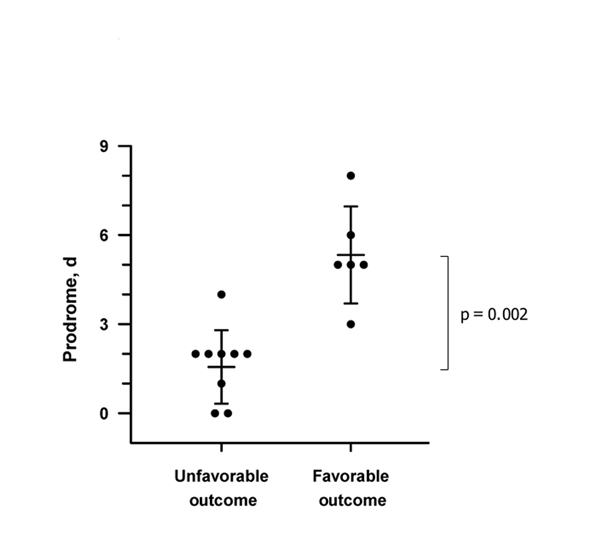Volume 19, Number 2—February 2013
CME ACTIVITY - Synopsis
Eastern Equine Encephalitis in Children, Massachusetts and New Hampshire,USA, 1970–2010
Figure 2

Figure 2. . . . . . Association of length of prodrome with clinical outcome in children with eastern equine encephalitis. Clinical outcome at the time of hospital discharge was defined by using a modified Pediatric Cerebral Performance Category scale (PCPC) (27). Error bars represent standard deviation; the central lines are the mean. The Mann-Whitney rank-sum test was used to compare the prodrome lengths for patients with favorable outcomes with those for patients with unfavorable outcomes. Prodrome is defined as the time from initial illness symptom to first neurologic symptom. Unfavorable outcome is defined as a PCPC score of 4–6, which includes death and severe neurologic disabilities. Favorable outcome is defined as a PCPC score of 1–3, which includes complete recovery and mild to moderate neurologic disability.
References
- Centers for Disease Control and Prevention. Eastern equine encephalitis—New Hampshire and Massachusetts, August–September 2005.MMWR Morb Mortal Wkly Rep. 2006;55:697–700 .PubMedGoogle Scholar
- Calisher CH. Medically important arboviruses of the United States and Canada.Clin Microbiol Rev. 1994;7:89–116 .PubMedGoogle Scholar
- Deresiewicz RL, Thaler SJ, Hsu L, Zamani AA. Clinical and neuroradiographic manifestations of eastern equine encephalitis.N Engl J Med. 1997;336:1867–74. DOIPubMedGoogle Scholar
- Przelomski MM, O'Rourke E, Grady GF, Berardi VP, Markley HG. Eastern equine encephalitis in Massachusetts: a report of 16 cases, 1970–1984.Neurology. 1988;38:736–9. DOIPubMedGoogle Scholar
- Centers for Disease Control and Prevention. Eastern equine encephalitis: epidemiology and geographic distribution [cited 2012 Sept 25]. http://www.cdc.gov/EasternEquineEncephalitis/tech/epi.html#moremapschartstables
- Eastern equine encephalitis (EEE). Department of Health: information for a healthy New York [cited 2012 Oct 1]. http://www.health.ny.gov/diseases/communicable/eastern_equine_encephalitis/fact_sheet.htm
- Health and Human Services. Massachusetts. Massachusetts arbovirus surveillance: humans [cited 2012 Sept 25]. http://westnile.ashtonweb.com/index42.asp
- Vermont.gov—the official state website. News releases. Health commissioner confirms second death from EEE [cited 2012 Sept 25]. http://www.vermont.gov/portal/government/article.php?news=3834
- Gibney KB, Robinson S, Mutebi JP, Hoenig DE, Bernier BJ, Webber L, Eastern equine encephalitis: an emerging arboviral disease threat, Maine.Vector Borne Zoonotic Dis. 2011;11:637–9. DOIPubMedGoogle Scholar
- Eastern equine encephalitis—Canada (03) (Nova Scotia). ProMed. 2009 Nov 3. http://www.promedmail.org, archive no. 20091105.3826.
- Feemster RF. Outbreak of encephalitis in man due to the eastern virus of equine encephalomyelitis.Am J Public Health Nations Health. 1938;28:1403–10. DOIPubMedGoogle Scholar
- Farber S, Hill A, Connerly ML, Dingle JH. Encephalitis in infants and children caused by the virus of the eastern variety of equine encephalitis.JAMA. 1940;114:1725–31. DOIGoogle Scholar
- Letson GW, Bailey RE, Pearson J, Tsai TF. Eastern equine encephalitis (EEE): a description of the 1989 outbreak, recent epidemiologic trends, and the association of rainfall with EEE occurrence.Am J Trop Med Hyg. 1993;49:677–85 .PubMedGoogle Scholar
- Centers for Disease Control and Prevention. Arboviral diseases, neuroinvasive and non-neuroinvasive; 2011 case definition [cited 2011 Sept 28]. http://wwwn.cdc.gov/NNDSS/beta/bcasedef.aspx?CondYrID=616&DatePub=1/1/2011 12:00:00 AM
- Levitt LP, Lovejoy FHJr, Daniels JB. Eastern equine encephalitis in Massachusetts—first human case in 14 years.N Engl J Med. 1971;284:540. DOIPubMedGoogle Scholar
- Fiser DH. Assessing the outcome of pediatric intensive care.J Pediatr. 1992;121:68–74. DOIPubMedGoogle Scholar
- Fothergill LD, Dingle JH, Farber S, Connerly ML. Human encephalitis caused by the virus of the eastern variety of equine encephalomyelitis.N Engl J Med. 1938;219:411. DOIGoogle Scholar
- Barnett GH, Ropper AH, Romeo J. Intracranial pressure and outcome in adult encephalitis.J Neurosurg. 1988;68:585–8. DOIPubMedGoogle Scholar
- Shetty R, Singhi S, Singhi P, Jayashree M. Cerebral perfusion pressure—targeted approach in children with central nervous system infections and raised intracranial pressure: is it feasible?J Child Neurol. 2008;23:192–8. DOIPubMedGoogle Scholar
- Di Rienzo A, Iacoangeli M, Rychlicki F, Veccia S, Scerrati M. Decompressive craniectomy for medically refractory intracranial hypertension due to meningoencephalitis: report of three patients.Acta Neurochir (Wien). 2008;150:1057–65. DOIPubMedGoogle Scholar
- González Rabelino GA, Fons C, Rey A, Roussos I, Campistol J. Craniectomy in herpetic encephalitis.Pediatr Neurol. 2008;39:201–3. DOIPubMedGoogle Scholar
- Golomb MR, Durand ML, Schaefer PW, McDonald CT, Maia M, Schwamm LH. A case of immunotherapy-responsive eastern equine encephalitis with diffusion-weighted imaging.Neurology. 2001;56:420–1. DOIPubMedGoogle Scholar
- Lury KM, Castillo M. Eastern equine encephalitis: CT and MRI findings in one case.Emerg Radiol. 2004;11:46–8. DOIPubMedGoogle Scholar
- Morse RP, Bennish ML, Darras BT. Eastern equine encephalitis presenting with a focal brain lesion.Pediatr Neurol. 1992;8:473–5. DOIPubMedGoogle Scholar
- Kalita J, Misra UK. Comparison of CT scan and MRI findings in the diagnosis of Japanese encephalitis.J Neurol Sci. 2000;174:3–8. DOIPubMedGoogle Scholar
- Kim JH, Booss J, Manuelidis EE, Duncan CC. Human eastern equine encephalitis. Electron microscopic study of a brain biopsy.Am J Clin Pathol. 1985;84:223–7 .PubMedGoogle Scholar
- Garen PD, Tsai TF, Powers JM. Human eastern equine encephalitis: immunohistochemistry and ultrastructure.Mod Pathol. 1999;12:646–52 .PubMedGoogle Scholar